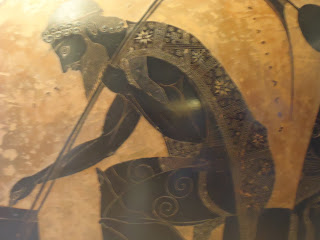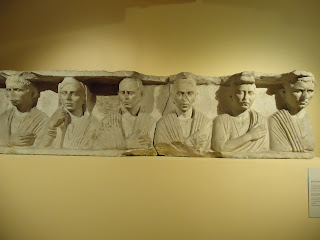As is pretty much accepted as fact by anthropologists, sociologists, historians, and biologists alike, race is a social construct that is not grounded in any biological facts. The "science of man" emerged from colonialism and slavery. The terminology is still used by physical and, in particular, forensic anthropologists, but the scientists pretty much all agree that
This is not to say that there are no legitimate physical variations among humans. Even the ancient Greeks recognized this reality. Take the Attic vase pictured. Represented is the myth of Andromeda. Andromeda was the daughter of Cepheus, a Phoenician (he was the son of Phoenix) and of Casseopeia (maybe an immigrant like Cepheus, maybe not). They were the mythical king and queen of Ethiopia. Andromeda is the figure being supported by the two smaller boys. Cepheus is the seated figure--they are both represented as "Persian" types--the hats and animal print pants are your typical dead give away.
The physical features of the Phoenician characters, however, are indistinguishable from how Greeks would represent themselves--as Perseus is represented standing in travel gear near Cepheus. The other figures are all "Ethiopians" marked by their facial features (though clothed Greek-style). Here is another version of the same scene, though the painter uses skin tone instead of features as a marker for the "Ethiopian" characters and clothing (again) for the Phoenician.
What is the point? The point is that there IS recognizable physical variation in humanity, but that physical variation does not make "race" more than a socially constructed reality. And that physical difference didn't mean that some of the people were somehow inherently better than others. I put "Ethiopian" in quotation marks because, technically, all the character except Perseus in the vases are Ethiopian--Andromeda, Cepheus, and the rest.
The Greeks recognized physical difference, but generally didn't think the people who had them were any more different from them than people in another family or in one Greek city-state and another (they used the same term, genos for everything from ones direct offspring to a household to women to a generation to what we might refer to as an ethnic group). The flexibility of such terms shows their constructedness. Those who appeal to biologically rigid categories of "race" don't seem to understand their fallacy. They appeal to physical anthropology as a defense for dismissing the realities of diversity in the name of coopting all historically "important" cultures to "whiteness". In reality, "white" only came to encompass the Mediterranean in the 1930s or 1940s at the earliest.
But, what basis in fact do the appeals commenters make to these categories of race science and physical anthropology? In an in depth review (from 2013) of a special issue of the American Journal of Physical Anthropology (2009) titled "Race Reconciled" at Living Anthropologically (which you should read regularly if you want to say you know anything about what is happening in physical anthropology circles), we learn that leading physical anthropologists find skin color incapable of denoting race, cranial measurements only useful for locating possible geographic region of decent, and, the relationship between geographic descent group and genetic phenotype as "subjective". Use of skin color itself is called "arbitrary and subjective" and the scientists state that no actual group clusters or "races" can be discerned by skin color. One author, John Relethford, author of the textbook The Human Species, states of "race" that it is
"Race is not an accurate or productive way to describe human biological variation" (Race Reconciled, 2009: 2; special issue of The American Journal of Anthropology)
The pseudo-science of race even in its own day was considered highly questionable and was abandoned almost entirely around World War II. Nevertheless, the internet (and some die-hard ideologues) persists. For example (from a FB comment on my last blog post),
Note the terms. They exactly mirror the terms shown in the 1950s encyclopedia entry pictured above. Those terms derive from 19th century race scientists like Blumenbach, but are also incorporated non-Europeans into the category of "white", based on the linguistic category "Indo-European", conflating language family trees with made up biological categories, none of which are reflected in skin tones and none of which are considered very useful or accurate today (despite their perpetuation in popular fiction).“not africanoid its negroid. Its a valid descriptive term among physical anthropologists. African is a geographical term not a race. We North Africans are "Africanoids" too=caucasoid Mediterranean”
This is not to say that there are no legitimate physical variations among humans. Even the ancient Greeks recognized this reality. Take the Attic vase pictured. Represented is the myth of Andromeda. Andromeda was the daughter of Cepheus, a Phoenician (he was the son of Phoenix) and of Casseopeia (maybe an immigrant like Cepheus, maybe not). They were the mythical king and queen of Ethiopia. Andromeda is the figure being supported by the two smaller boys. Cepheus is the seated figure--they are both represented as "Persian" types--the hats and animal print pants are your typical dead give away.
The physical features of the Phoenician characters, however, are indistinguishable from how Greeks would represent themselves--as Perseus is represented standing in travel gear near Cepheus. The other figures are all "Ethiopians" marked by their facial features (though clothed Greek-style). Here is another version of the same scene, though the painter uses skin tone instead of features as a marker for the "Ethiopian" characters and clothing (again) for the Phoenician.
What is the point? The point is that there IS recognizable physical variation in humanity, but that physical variation does not make "race" more than a socially constructed reality. And that physical difference didn't mean that some of the people were somehow inherently better than others. I put "Ethiopian" in quotation marks because, technically, all the character except Perseus in the vases are Ethiopian--Andromeda, Cepheus, and the rest.
The Greeks recognized physical difference, but generally didn't think the people who had them were any more different from them than people in another family or in one Greek city-state and another (they used the same term, genos for everything from ones direct offspring to a household to women to a generation to what we might refer to as an ethnic group). The flexibility of such terms shows their constructedness. Those who appeal to biologically rigid categories of "race" don't seem to understand their fallacy. They appeal to physical anthropology as a defense for dismissing the realities of diversity in the name of coopting all historically "important" cultures to "whiteness". In reality, "white" only came to encompass the Mediterranean in the 1930s or 1940s at the earliest.
But, what basis in fact do the appeals commenters make to these categories of race science and physical anthropology? In an in depth review (from 2013) of a special issue of the American Journal of Physical Anthropology (2009) titled "Race Reconciled" at Living Anthropologically (which you should read regularly if you want to say you know anything about what is happening in physical anthropology circles), we learn that leading physical anthropologists find skin color incapable of denoting race, cranial measurements only useful for locating possible geographic region of decent, and, the relationship between geographic descent group and genetic phenotype as "subjective". Use of skin color itself is called "arbitrary and subjective" and the scientists state that no actual group clusters or "races" can be discerned by skin color. One author, John Relethford, author of the textbook The Human Species, states of "race" that it is
“a culturally constructed label that crudely and imprecisely describes real variation” (Race Reconciled 2009:20).This is not a new idea, of course (see link above)--the linked anthropology issue came out in 2009, which means the research was being done long before that and builds upon decades of earlier research. And, even Relethford's connection of craniometrics and genetics is increasingly being demonstrated to be inaccurate. For over 30 years now, as the articles at Living Anthropologically show, calls have been made within the field for admitting to the subjectivity and ideological underpinnings of racial classification by forensic science.
In another of the articles, titled "Understanding race and human variation: Why forensic anthropologists are good at identifying race" the conclusion is that forensic scientists are so good at categorizing bones by race because the categories are, essentially, made up. Forensic scientists could just as easily invent a new classification system for humans and define our differences through that. In fact, the author attributes the ability to categorize bones by racial groups to "institutional racism". Another article in the volume asserts that the methods of forensic anthropologists themselves lead to racist classifications. The image below, from Nott's 1854 Types of Mankind might give readers a clue as to what type of racial bias has been present. Nott's so-called "science" was considered illegitimate and motivated by prejudice when it was published. The anthropologist to whom the book was dedicated (Samuel George Morton) essentially disavowed it.
What does this all mean in terms of people who dismiss diversity in antiquity? Well, the same commenter who had recourse to the pseudo-scientific language of race science to try to co-opt all Mediterranean peoples to their own whiteness showed their cards by committing all three of the actions I identified in my post. First, the individual posted a link to my Eidolon article and charged I advocate "changing history" in the name of "POLITICAL CORRECTNESS" [their caps] and in order to build the self esteem of minorities. Additionally, the individual used an appeal to "genetics" (out-dated physical anthropology discussed above that not even physical anthropologists support) to manipulate the category of "whiteness" to dismiss my points.
All of this amounts to an attempt to dismiss the last 50 or so years of scholarship on race and ethnicity in the ancient Mediterranean and in anthropology as "revisionist" But that shouldn't be a bad thing. My fellow scholars and I are revisionist--we critically examine the past scholarship, bring in new evidence, and address methodological biases in order to correct the misrepresentations and manipulations of the 19th and early 20th centuries done in the name of appropriating Greek and Roman (and Egyptian and Persian) cultures for a mythical and supposedly superior "Anglo-Saxon white race". The general public doesn't seem to be ready to let it go. But, wouldn't it just be easier to admit that the world is and always has been full of people with differences and that this is ok? Instead, people clinging to the world view that "whiteness" is a biological reality march around carrying tiki torches in the name of their superiority, chanting "Blood and Soil" as if they were not immigrants in this land we call America.






















































